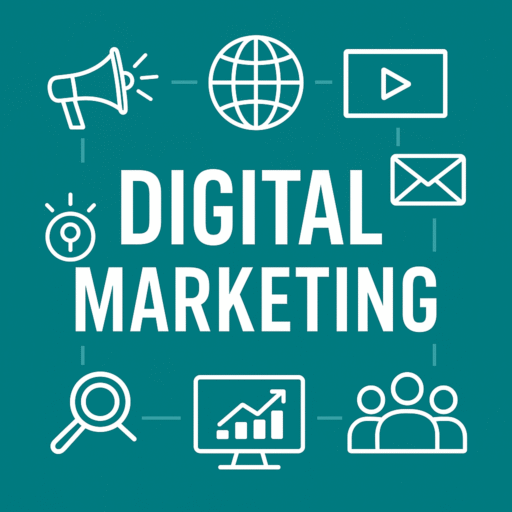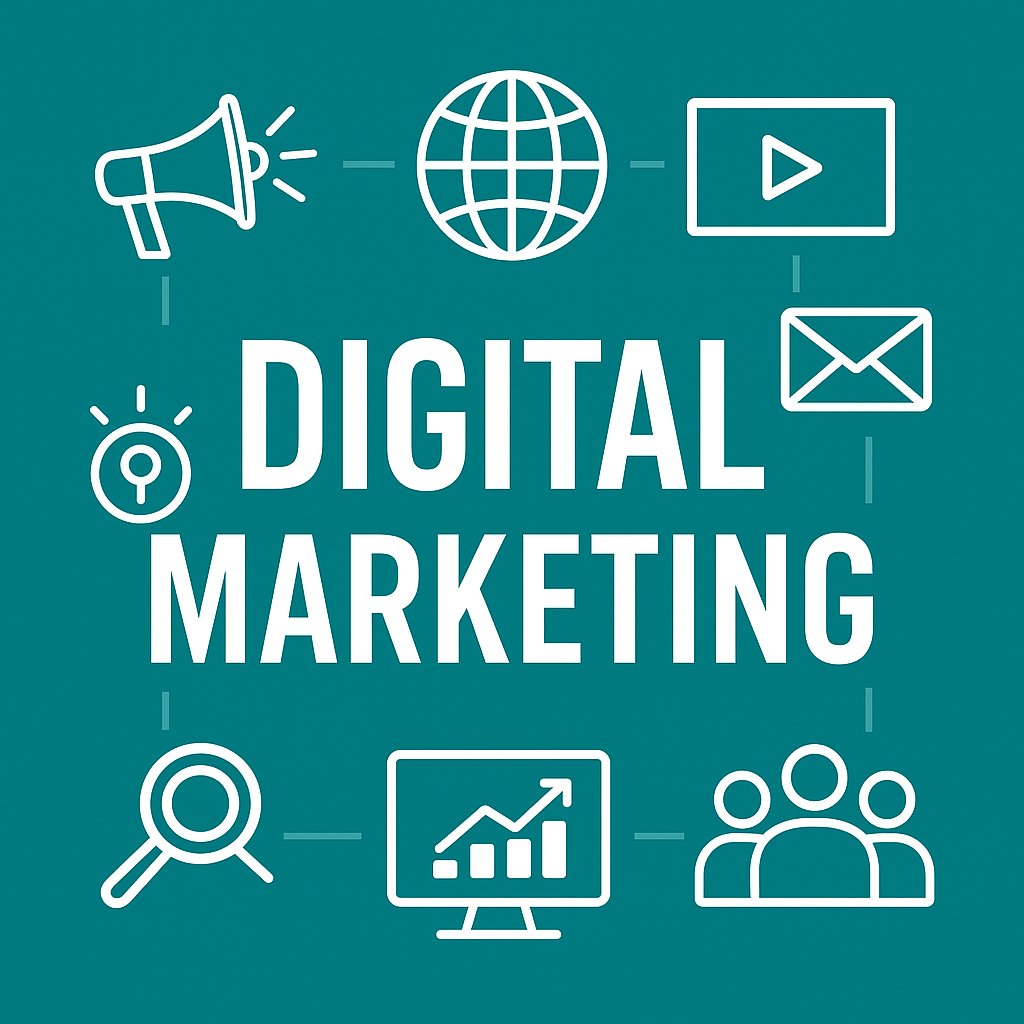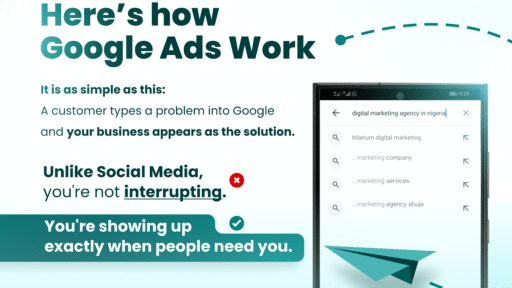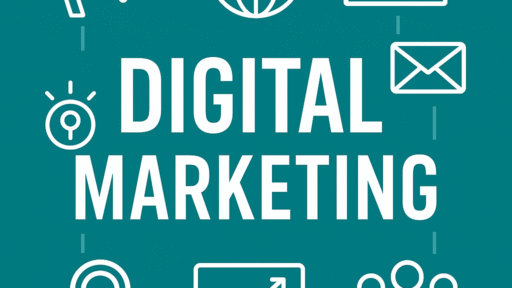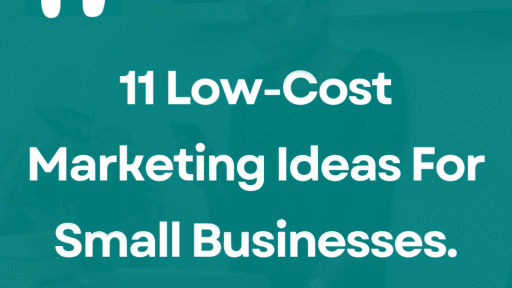Welcome back —I’m Hilary Onyejekwe, and I know how exciting and sometimes daunting it can feel when you’re running a small business and want to get more customers. That’s why I put together this guide: Digital Marketing for Small Business: 10 Best Strategies. My goal? To make digital marketing feel as simple as explaining it to a 10-year-old—but powerful enough to bring in customers.
Imagine your business is like a Suya stand. Digital marketing is like putting up bright signs, telling your neighbours where you are, sharing pictures of tasty Suya, and inviting them again later—all without spending a fortune. In this article draft, I’ll walk you through the details—what to do, why it matters, plus live stats to back it up. Ready? Let’s start.
Table of Contents
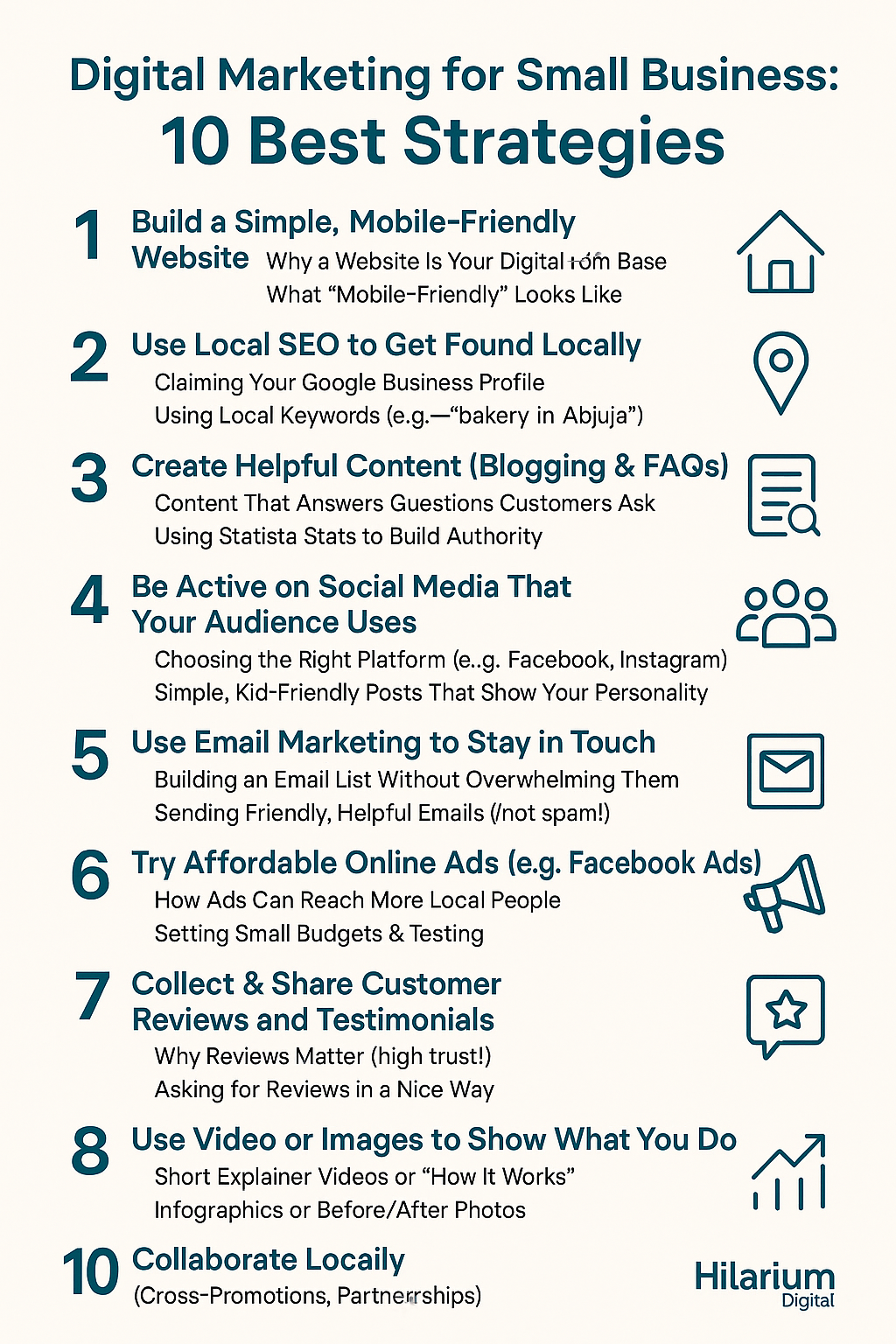
Why Digital Marketing Matters for Small Businesses
I’ve seen it: small business owners pouring all their time into making a great product—bread baking, tailoring, tutoring, you name it—yet not getting the customers they deserve. The world is online now. Folks look things up on their phones or computers before they ever leave the house. If you’re not there, you miss out.
Here’s why digital marketing matters a lot—a few simple ideas:
- Reaching More Customers, Anytime, Anywhere
There are billions of searches online daily—from homes to markets to buses. You probably found this article through a search. Your business can be found even when you’re not open physically. That’s like having a 24/7 Suya stand sign that works even in the rain! - More Affordable Than Traditional Ads
Digital tools like social posts or search listings often cost way less than TV, magazines, or radio ads. Plus, you only pay when someone is interested—say they click your ad—to come see what you offer. It stretches your money further. See? - It Helps Build Trust
When people see a friendly website or a helpful post, they feel like they know you. Throw in a customer review—and that trust grows fast. According to Statista, businesses with positive reviews can see up to 10–20 % more sales compared to those without reviews. Collect reviews the right way daily. - You Can Measure What Happens
Using tools like Google Analytics or Facebook Insights, you can see how many people visited, clicked, or messaged you. No guessing—just real numbers you can learn from and make decisions. Analytics helps you make informed decisions. - It’s Grow-Over-Time Friendly
Start small—maybe a basic website or a simple Facebook post—and build from there. As your business grows, your marketing grows too, without needing huge budgets all at once. This is how we have helped many businesses like yours grow using our proven strategies.
So, digital marketing is like giving your small business wings—it helps you fly above your local neighborhood and land in front of more ideal customers… easily, affordably, and smartly.
1. Build a Simple, Mobile-Friendly Website
Every business needs a home online—and that’s your website. Think of it like your business’s front door on the internet: it’s where customers land, learn about you, and know what to do next. To test things out, check out Google Sites.
Why a Website Is Your Digital Home Base
Here’s why having a website matters—even if you also post on social media:
- You control it. Social platforms can change rules or limit your posts. But your website? You decide what’s on it, how it looks, and what people see.
- It builds credibility. Even a simple one-page site saying “Hi, I’m [Your Business Name], here’s what I do, where I am, and how to contact me” shows you’re serious.
- It’s searchable. A well-built website with the right words helps Google find you when people search.
- Future-proof. Down the road, you can add a blog, testimonials, or even sell online.
What “Mobile-Friendly” Looks Like
Most people in Abuja (and across the globe!) use phones to surf the internet. So your site has to look good and work smoothly on small screens. That means:
- Easy to read text without zooming
- Buttons big enough to tap with a finger
- Fast loading—because slow sites make people leave
I always check my site on my phone first—it’s that important. This is also a very important ranking factor for most search engines.
2. Use Local SEO to Get Found Locally
Okay, let’s say someone nearby wants “custom t-shirt printing Abuja.” You want your business to pop up in that search. That’s local SEO—making your business easy to find.
Claiming Your Google Business Profile
Google Business Profile (formerly Google My Business) is free and very powerful.
- You should add your business name, address, phone number, website link—even hours and photos.
- That way, when someone searches, they see your info and a map—right there in a neat box.
- Don’t forget to ask customers to leave a quick review—it makes your listing more trustworthy and real.
Using Local Keywords (e.g., “bakery in Abuja”)
For your website or posts, sprinkle in words that people nearby actually search—like “digital marketing agency Abuja” or “best bakery in Gwarinpa.”
- Put those words in titles (“Best Bakery in Gwarinpa – [Your Name]”), page text (“Welcome, I bake cakes in Gwarinpa…”), and even the website’s metadata (behind-the-scenes settings).
- You don’t need to be fancy—just be clear, helpful and natural.
3. Create Helpful Content (Blogging & FAQs)
One of the smartest ways I’ve helped small businesses grow is by creating content that answers the exact questions customers are already asking. If you think about it, Google is a giant “answer machine.” When you provide the answers, you earn people’s trust—and Google’s attention.
Content That Answers Questions Customers Ask
Let’s say you run a small tailoring shop, for instance. A potential customer types in, “Best fabric for hot weather in Abuja.” If you have a blog post titled “Best Fabrics for Hot Nigerian Weather – Tailor’s Advice”, you’re already ahead of competitors who have nothing on their site.
Here’s what works well:
- Blog Posts: Articles like “5 Tips for Choosing a Wedding Cake in Abuja” or “How to Care for Your Ankara Fabrics.”
- FAQ Pages: A list of common questions and answers about your business (“Do you deliver?” “How long does an order take?”). This helps give clarity to your audience.
- Guides & How-Tos: Step-by-step advice, preferably with pictures.
Using Statista Stats to Build Authority
When you back up your content with numbers, you show authority. For example, according to Statista, over 4.6 billion people worldwide were active internet users in 2024, with mobile devices accounting for almost 60% of web traffic. That means if your content isn’t online and mobile-friendly, you’re missing out on a huge piece of the pie.
By using relevant stats like these, you make your advice more trustworthy. People don’t just think, “Hilary says so,”—they think, “Hilary knows this because the data backs it up.
4. Be Active on Social Media That Your Audience Uses
When I first started helping small businesses, I noticed a common mistake: trying to be on every social media platform. That’s like trying to sell Suya at 10 different street corners at once—you just can’t do it well. Instead, I focus on where my audience hangs out.
Choosing the Right Platform (e.g., Facebook, Instagram)
Different businesses shine on different platforms:
- Facebook: Great for community-based businesses, events, and longer posts.
- Instagram: Perfect for showing beautiful products (food, clothes, crafts).
- TikTok: Works if you can make short, fun, or behind-the-scenes videos.
- LinkedIn: Ideal for B2B (business-to-business) services.
Simple, Kid-Friendly Posts That Show Your Personality
Think of your social media like a conversation, not a sales pitch. Share:
- Behind-the-scenes moments: “Here’s how I make your bread fresh every morning.”
- Customer spotlights: “Meet Jane, who just bought her graduation dress from us.”
- Tips & quick advice: “How to store cupcakes overnight without losing freshness.”
According to Statista, social media ad spending in Nigeria is projected to reach $77.37 million in 2025. Even if you don’t run ads, organic social media presence is free visibility you can’t ignore.
5. Use Email Marketing to Stay in Touch
Email marketing might sound old-school, but it works—especially for small businesses that want repeat customers. The beauty of email is that you own your list. If Facebook or Instagram changes its rules tomorrow, your email list is still yours.
Building an Email List Without Overwhelming Them
Start simple:
- Offer a small freebie or discount for signing up (“Join my list and get 10% off your first order”).
- Add a sign-up form to your website and social media profiles.
- Collect emails in-store with a small clipboard or digital tablet.
Sending Friendly, Helpful Emails (Not Spam!)
Once people sign up, treat them like friends. Send:
- Updates about new products/services.
- Helpful tips (“5 ways to style your handmade jewelry”).
- Special offers just for subscribers.
According to Statista, email marketing revenue worldwide is expected to reach $17.9 billion by 2027. That’s proof that businesses, big and small, still rely on it for customer retention.
6. Try Affordable Online Ads (e.g., Facebook Ads)
I know—ads can feel intimidating, especially if you’re working with a tight budget. But here’s the truth: you don’t need millions to advertise online. You just need to be smart and targeted.
How Ads Can Reach More Local People
Unlike a billboard or a newspaper ad that shows to everyone, online ads can target only the people who matter to you—based on location, interests, or even recent searches.
For example:
- You own a restaurant in Abuja. With Facebook Ads, you can choose to show your promotion only to people within a 5km radius who have shown interest in “African cuisine” or “restaurants.”
- You pay only when they see or interact with your ad.
Setting Small Budgets & Testing
Here’s how I usually recommend starting:
- Begin with a small daily budget—even ₦1,500–₦2,000/day.
- Run different versions of your ad (different pictures or headlines) to see which works best.
- Track the results—if one ad gets more clicks, keep it running. If another fails, stop it.
According to Statista, global digital advertising spending reached $627 billion in 2024, and it’s still growing. That tells you—businesses wouldn’t spend that much unless it worked.
7. Collect & Share Customer Reviews and Testimonials
Reviews are pure gold for small businesses. Why? Because people trust people more than they trust marketing claims. If a customer says, “Hilary’s agency helped my sales triple,” that’s more powerful than me saying it myself.
Why Reviews Matter (High Trust!)
Statista reports that over 90% of shoppers read online reviews before buying. That means if you’re not showing customer feedback, you’re missing a big trust-builder.
Reviews help:
- Boost your Google ranking (more positive reviews = higher local search visibility).
- Increase conversions (people are more likely to choose you over a competitor).
- Reassure hesitant buyers that you’re worth it.
Asking for Reviews in a Nice Way
Many customers are happy to leave a review—they just need a little nudge. Try:
- Sending a short thank-you message with a review link after a purchase.
- Offering a small incentive (discount on their next order) in exchange for honest feedback.
- Displaying reviews on your website and social media.
8. Use Video or Images to Show What You Do
We live in a scroll-happy world. And guess what stops the scroll? Eye-catching visuals—especially videos.
Short Explainer Videos or “How It Works”
You don’t need Hollywood-quality production. Your phone camera is enough. People love seeing:
- Behind-the-scenes clips (“Here’s how I make your order”).
- Quick tips (“3 ways to keep bread fresh for a week”).
- Customer transformations (“Before and after my cleaning service”).
Infographics or Before/After Photos

Not everyone likes reading long texts. Infographics can simplify your message:
- Show steps (“Order → Payment → Delivery”).
- Present stats (“80% of my orders are repeat customers”).
Statista shows that video content consumption on mobile devices accounts for over 75% of total online video viewing. That’s why if you’re not creating videos yet, you’re leaving attention (and money) on the table.
9. Collaborate Locally (Cross-Promotions, Partnerships)
One of the fastest ways I’ve helped small businesses grow is by teaming up with other businesses nearby. It’s like having two Suya stands side-by-side, but each one tells customers, “Hey, go check them out too.” Everyone wins.
Working with Nearby Businesses
Here’s how to do it without overcomplicating things:
- Partner with complementary businesses. For example, if you own a coffee shop, team up with a bakery. Customers buying bread get a discount at your café, and vice versa.
- Share each other’s promotions. Post about them on your social media, and they post about you.
- Bundle products or services. A spa and a nail salon could sell a joint “self-care package.”
Community Sharing = More Exposure
Local collaborations work because they build trust—if a customer already trusts one business, they’re more likely to trust yours. According to Statista, 78% of consumers are more likely to try a new business when it’s recommended by another business they trust.
And this doesn’t have to cost a thing—sometimes, all it takes is a friendly conversation and a shared Instagram post.
10. Track What Works (Google Analytics, Insights)
Here’s the thing: doing all this marketing is great, but if you don’t track it, you’re flying blind. I’ve seen businesses post daily, run ads, and hand out flyers—but have no idea which one is bringing in customers.
Look at Simple Numbers That Show Growth
Don’t worry—you don’t need to be a “data geek” to track results. Start with:
- Website traffic (Google Analytics shows you how many people visit, where they come from, and what pages they like most).
- Social media insights (Facebook and Instagram show reach, engagement, and link clicks).
- Email open rates (your email tool will show you how many people opened and clicked).
Adjust What Doesn’t Work & Do More of What Does
If a post about your new product got tons of engagement, try posting similar ones. If an ad got no clicks, tweak the image or wording.
Statista confirms that data-driven decision-making can increase marketing ROI by up to 20%. That’s proof that even small tracking habits can lead to big results.
Conclusion
If you’ve read this far, you now have 10 practical digital marketing strategies you can start using today. And remember—you don’t have to do them all at once. Pick one or two, get comfortable, and build from there.
The beauty of digital marketing is that it grows with you. Start small, stay consistent, and you’ll see results. I’ve used these exact strategies to help small businesses in Abuja and beyond turn slow days into sold-out days.
📢 Here’s my invitation to you: If you’re a small business owner and you want someone to guide you step-by-step—without wasting your money on things that don’t work—reach out to my agency. At Hilarium Digital, my team and I help businesses like yours get found online, attract the right customers, and grow sustainably.
Let’s turn your business into the one people can’t stop talking about.
FAQs
Q1 – What is Digital Marketing?
Digital marketing utilizes the internet—through websites, social media, email, and ads—to promote your business, connect with customers, and drive sales growth.
Q2 – How much does it cost to get started?
You can start for free (social media posts, Google Business Profile) and add small paid ads as you grow.
Q3 – Do I need to hire someone, or can I do it myself?
You can do it yourself, but hiring a professional (like my agency) can save time and help you see results faster.
Q4 – How long until I see results?
Some strategies, like ads, can work in days. Others, like SEO, take weeks or months to build momentum.
Q5 – Can I track if it’s working?
Absolutely! Tools like Google Analytics and social media insights make it easy to measure what’s bringing in results.

